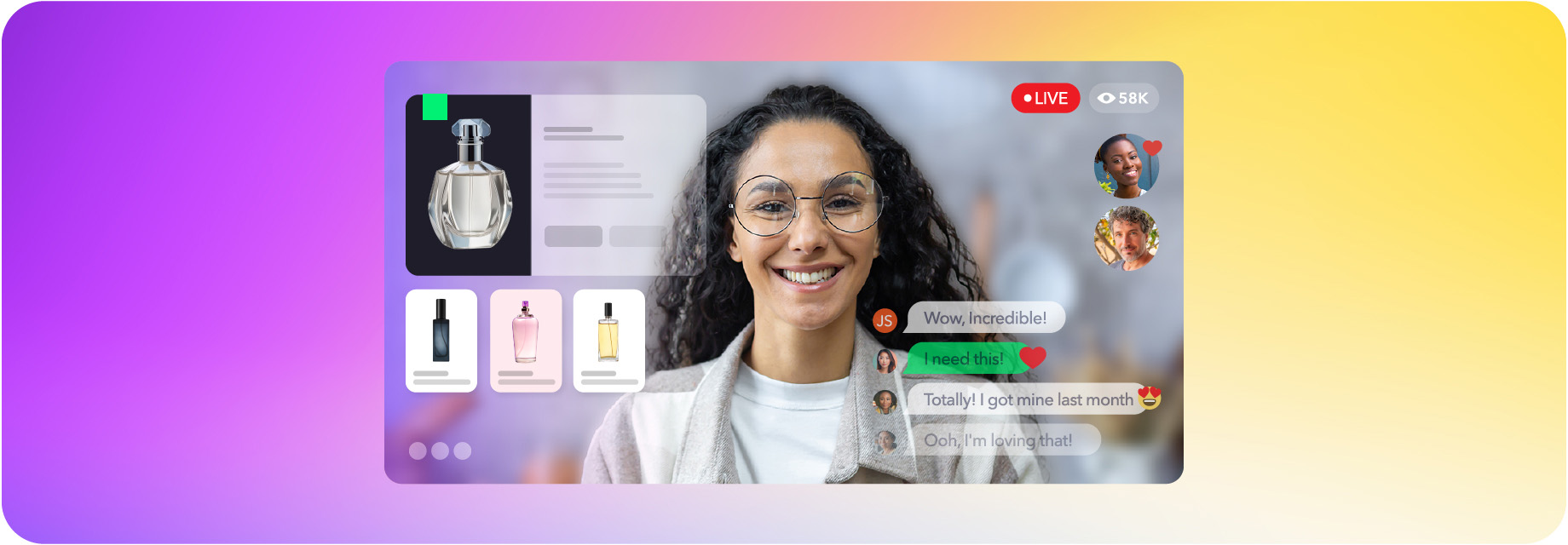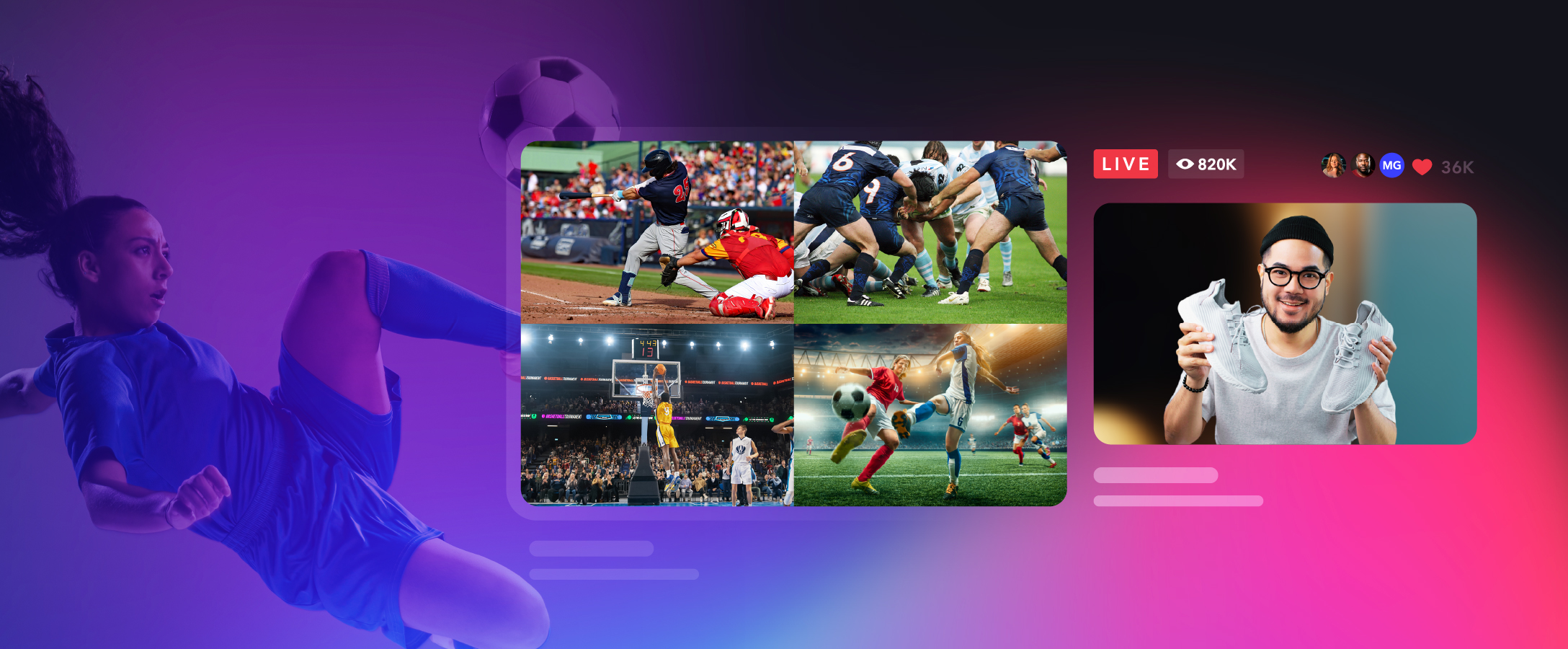Streaming a shopping event in real time provides several opportunities for e-commerce businesses. It enables you to sell to customers in a way that feels like a real-life salesroom, resulting in a boost in sales and increased brand awareness.
These sorts of shopping experiences are made possible by the support of innovative live commerce technology. In this guide, we will share everything you need to know about live commerce, including how it works, its advantages and limitations, and how to host or participate in a live event.
What is live shopping?
Live shopping, also known as live stream shopping or live commerce, is a video monetization and sales channel that involves selling products through live video streams. This is a powerful medium businesses can leverage to generate more profit, outperform competitors, and increase brand awareness.
This sales avenue enables organizations to showcase their products on a live shopping stream via a real-time broadcast on social media or other platforms. As a result, consumers can learn how the product works and see it in action, which may encourage them to make a purchase.
A brief history of live shopping
Before we dive further into how live shopping works, let’s briefly shift gears to discuss the history of this sales channel.
Live shopping started with the introduction of QVC, which stands for “Quality, Value, and Convenience.” QVC is a free television network that pioneered and popularized the televised shopping experience for Americans. QVC has evolved over the years to align with current technology trends (i.e., live streaming, mobile devices, and social media) and capitalize on the booming industry.
The shoppable streaming market in China reached $317 billion in 2021, with live commerce experiencing a surge following the introduction of Taobao Live. This form of shopping is particularly popular in East Asian countries, with influencers generating millions of views and sales.
Live shopping is gaining popularity worldwide, particularly in North America. The live streaming market value in the United States is set to hit $55 billion by 2026.
Other shopping platforms continue to emerge, enabling businesses to sell their products via real-time broadcasts on large platforms, such as Amazon and TikTok. Facebook also had a live shopping feature on its platform, but it was discontinued in October 2022.
Thanks to the development of live commerce technology, it is now possible for e-commerce brands to embed their live shopping experiences directly into their websites or apps.

How does live commerce work?
With live shopping, viewers tune in to a stream where a host presents various products in real-time. The host typically explains how the product should be used or demonstrates it to highlight its key features, encouraging the audience to make a purchase.
For example, clothing brands may utilize live commerce to demonstrate how their garments can be styled and fit for various sizes and heights. Many retailers often offer special deals that are only available during the stream.
If a viewer is interested in the product, they can buy it directly on the streaming platform or the brand’s website. In other instances, the audience will place bids on the items they’re interested in, and the individual with the highest bid gets to take it home.
Examples of live commerce platforms
Several social media platforms and e-commerce marketplaces offer live shopping capabilities. Some platforms allow user-generated content from any user, while others restrict it to specially selected users who are authorized to sell products.
Popular platforms commonly used for live shopping include:
- Amazon
- YouTube
- Taobao
- TalkShopLive
- TikTok
- Popshop Live
- eBay Live
- Klarna
- ShopShops
- QVC
These third-party platforms are ideal for content creators seeking to capitalize on live shopping as a revenue stream. However, retailers who wish to utilize this medium as a sales channel for their own business are often better off incorporating live shopping experiences directly into their websites or apps.
By hosting the live shopping streams themselves, retailers can eliminate the middleman, giving them more flexibility on the user experience. This also helps to reduce fees or commissions paid out to a third-party platform, improving the bottom line.
7 Benefits of live shopping
There are several advantages to conducting a live sale on streaming platforms. Live commerce is a rapidly growing industry that offers numerous opportunities for businesses across various niches.
Here are seven benefits to leveraging this sales channel.
1. Mimics in-store shopping
Live commerce mimics the in-store shopping experience that is often lost with online shopping. This way, consumers can engage with a real person as they discuss products they’re interested in.
This is taken a step further with retailers who host interactive, unscripted streams, allowing viewers to experience genuine interactions with hosts.
2. Accessibility
Not every person enjoys going to the mall or retail stores to find the items they want and need. Many would rather make purchases online without ever leaving the comfort of their own home. Live streaming makes shopping more accessible, offering flexibility and convenience.
Statista reports that shoppers prefer to buy online and have their items shipped, with apparel, footwear, appliances, and home furnishings as the most popular products. Live shopping enables retailers to create an online experience that caters to this preference.
3. Higher engagement
Streaming platforms can help you engage more effectively with your audience, particularly on platforms that offer built-in features that enhance the viewing experience. The stream’s host can answer questions as they appear on the live chat, conduct polls, and more.
Additionally, you can establish trust and credibility with consumers by providing timely and accurate responses to their pressing questions.
4. Generate more sales
Sometimes, consumers may not be able to visit a physical retail store, but many can attend a live shopping event via their mobile device, television, laptop, or computer. As a result, they may be more inclined to purchase since they can see the product being used.
Additionally, live commerce taps into our desire to make impulse purchases, as products are typically sold at lower prices during the stream. Once the shopping event is over, consumers can no longer take advantage of the discounted prices.
5. Fewer returns on merchandise
There are many reasons shoppers may return the products they purchase online, such as when an item doesn’t look the same as the product image, doesn’t work as described, and so forth.
On average, purchases made during a live shopping stream have a 40% lower return rate than traditional e-commerce sales. This can be attributed to the fact that consumers can gain a better view of the product they’re considering buying and be more confident in their purchase.
6. Increase brand awareness
By increasing your following on social media networks and dedicated streaming platforms, you can build your brand’s awareness. In many cases, streaming and social media channels allow you to add tags to your broadcast, making it easy for viewers to find your stream organically.
7. Source of entertainment
Live streaming shopping events are not only helpful for consumers, but they’re also a source of entertainment. Like movies and television shows, shopping streams are sometimes scripted and shot in a professional set with make-up artists, good lighting, and more.
Additionally, these types of streams are often hosted by well-known influencers and celebrities to attract a larger audience. This helps engage the combined audiences of the e-commerce brand and its partner, who serves as a spokesperson for the brand.

Drawbacks of live shopping
Despite the several advantages, hosting an interactive live streaming shopping event also has a few drawbacks to consider.
One of the most significant disadvantages of live shopping events is that streamers can experience technical issues. For example, you may encounter high latency, which can result in a low-quality viewing experience. If your audio or video is unclear, viewers will struggle to understand you, and they will not receive an accurate presentation of the product.
To avoid issues, it’s essential to have the best streaming software and tools. With the support of a live commerce platform, such as Dolby OptiView, you can ensure that your viewers receive a near-zero latency live stream with the highest quality audio and video.
Live streams occur in real time, so you won’t be able to edit your mistakes while broadcasting. Errors may be corrected after the stream, but by then, viewers may have already purchased the product.
Although these drawbacks are possible, they are not typically enough to prevent e-commerce retailers from leveraging live shopping as a sales channel.
How to host a live shopping stream
Ready to start hosting live shopping streams on your e-commerce storefront? Here are the steps you can take to get started.
1. Choose a live commerce platform
The key to a successful live commerce strategy lies in choosing the right streaming solution for hosting your live shopping experiences. Here are some features you should look for as you compare options:
- In-stream checkout flow
- Real-time streaming
- Live chat
- Polls
- Q&As
- Easy sharing links
- Integrated social media feeds
Dolby OptiView’s innovative streaming solution is an excellent option for retailers seeking to deliver high-quality audio and video to their global audience. Our solution enables you to host live shopping experiences that keep viewers synchronized and engaged. Contact us to learn more about our product.
2. Build your streaming setup
Once you’ve identified which platform you’ll use to support your live shopping efforts, it’s time to invest in the equipment you’ll need for your stream, such as a webcam, ring light, microphone, and computer.
While you don’t have to purchase expensive equipment, using high-quality streaming products can enhance your broadcast. All of your tools should be compatible with your chosen live streaming platform.
3. Plan out your content
Next, you should start planning your content. Consider which products you want to sell and how you want to present them.
You’ll also need to create a schedule for your streams. Conduct research to identify your target audience’s peak viewing hours, allowing you to schedule streams accordingly and increase the likelihood of engagement and conversions. It’s best to be consistent when building your schedule.
Regardless of the schedule you create, prioritize consistency. Maintain a consistent schedule and brand presence.
4. Decide how to incorporate interactivity
Interactivity plays a crucial role in keeping your shoppers engaged. Fortunately, there are several easy ways to incorporate interactivity into your live shopping streams. Some standard techniques include:
- Provide limited-time promotions and deals
- Conduct live giveaways or contests
- Feature influencers to attract viewers
- Collaborate with other brands
- Include a live chat feed for shoppers to connect
After you’ve hosted a few streams, you’ll get an idea of what works best for engaging your audience.
Final thoughts
Live shopping is an excellent way for brands to generate more revenue while increasing brand awareness on different streaming platforms. Not only do live commerce streams provide entertainment, but they also make it easier for consumers who prefer online shopping to purchase the products they want.
If you’re interested in launching a live shopping feed on your site or app, you need the support of a robust solution like Dolby OptiView. Contact us to discover how we can assist you in getting your first live commerce stream up and running quickly.











